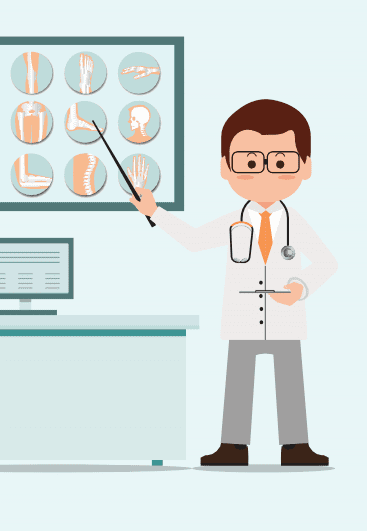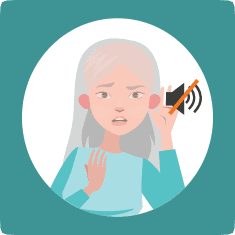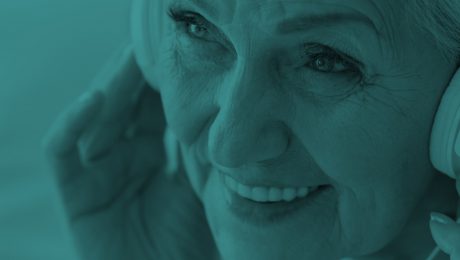WHAT SENIORS NEED TO KNOW ABOUT OSTEOPOROSIS
How Osteoporosis Affects Seniors
It’s likely that more than 200 million people are living with osteoporosis—especially common among older women. Learn how to prevent or manage it this National Osteoporosis Month.
It’s likely that more than 200 million people are living with osteoporosis, a medical condition marked by having fragile bones. This condition is especially common among older women, and it can be dangerous. (NCBI)
May is National Osteoporosis Month. Since seniors are at greater risk of this disease, it’s important to learn how to prevent or manage osteoporosis.
The Basic Facts of Osteoporosis
What Is Osteoporosis?

Everybody relies on their bones for strength, support, and more. Osteoporosis is a disease that weakens bones. As a result, bones are fragile and susceptible to risks like breaks and fractures. When combined with conditions like arthritis, osteoporosis can make tasks like moving around risky and painful.
Potential Outcomes of Osteoporosis:
- Breaks and fractures
- Complications resulting from breaks & fractures
- Poor posture
- Limited mobility
What Causes It?
For many people, osteoporosis is a side effect of aging. However, it can be exacerbated and accelerated by conditions like rheumatoid arthritis, stroke, and some cancers. Certain medications and negative habits, like poor nutrition, can also contribute.
Diagnosing Osteoporosis
Osteoporosis is diagnosed through a bone mineral density (BMD) test. Other exams and laboratory tests are sometimes administered as well. (National Osteoporosis Foundation)
![]()
WHAT SENIORS NEED TO KNOW ABOUT OSTEOPOROSIS
Osteoporosis Awareness Month
Home Care Tip
Since seniors are at greater risk of osteoporosis and falling, it’s important for you to learn how to avoid falls, including arranging a home safely and knowing how to get up and down safely. (National Osteoporosis Foundation)
Symptoms of Osteoporosis
If you are experiencing any of the following signs of bone loss, it is essential you be screened for osteoporosis and other bone-related diseases:
- Loss of height
- Aches without injury
- Poor posture
- Oral bone loss conditions
- Regular fractures
(WebMD)
Risk Factors
- Being a woman
- Getting older
- Being of Caucasian or Asian descent
- Family history
- Small body frame
- Unhealthy diet
- Lack of exercise
(Mayo Clinic)
Preventing and Managing Osteoporosis
Prevention Tips
Preventing osteoporosis protects seniors from bone-related problems. Consider incorporating the following:
- Calcium
- Vitamin D
- Regular exercise
- A balanced diet
Managing Osteoporosis
- Learn to prevent falls and what to do in case of a fall
- See a doctor for regular monitoring of disease progression
- Eat a bone-healthy diet and follow an exercise regimen
- Take medication to treat osteoporosis
(American Family Physician)
References:
- Published in ALZHEIMER, CAREGIVERS, DEMENTIA, IN HOME CARE
HELP SENIORS PREVENT HEARING LOSS

An In-Depth Look at Senior Hearing Loss
Age-related hearing loss affects many seniors. Here’s how to help seniors prevent further hearing loss and cope healthily.
About 1 in 3 adults between 65 and 74 years old experiences hearing loss. Since hearing loss can sometimes be reduced, it’s important for seniors to be aware of their auditory health. (NIDCD)
Difficulty hearing or making out sounds can put seniors at risk of social, health, and safety problems. Here are the hearing loss basics. (NAIA)
The Basics of Hearing Loss
Who experiences hearing loss?
Anyone can experience hearing loss, but it is especially common among older adults. As age increases, the risk of hearing impairment increases as well.
What causes hearing loss?
Damage from noise or certain diseases can cause hearing loss, but so can the simple deterioration that comes with age. Deterioration can be exacerbated by medical conditions like high blood pressure, exposure to noise, and other factors.
Are there different levels of hearing loss?
Age-related hearing loss is often gradual. What may begin as simply needing the TV volume louder can turn into being unable to make out words or sounds.
How can hearing loss be prevented?
Currently, hearing loss can’t be prevented entirely. However, it can be minimized or delayed by protecting against noise and avoiding common conditions (like diabetes) that put you at greater risk of hearing loss.
Is hearing loss dangerous?
Medically, age-related hearing loss is unlikely to cause other health problems. However, being hard of hearing can put you in risky situations, such as making it difficult to hear an alarm or understand important instructions spoken to you. (NIDCD)
![]()
HELP SENIORS PREVENT HEARING LOSS
C A R E G I V E R S
Home Care Tip
There are some apps that can be paired with hearing aids to customize options and preferences. Encourage seniors to embrace technology like this to make using hearing aids less frustrating.
Risks Associated With Hearing Loss
Impaired hearing can make it hard for seniors to hear at all, but can also make understanding words clearly difficult. As a result, seniors are at greater risk for:
- Misunderstanding doctor’s instructions
- Mishearing warnings or important statements
- Not hearing fire alarms or other emergency notifications
- Growing isolated due to less confidence in conversations
- Certain health issues, particularly those related to stress or balance
(Hopkins Medicine)
Hearing Loss by the Numbers
- Among adults over 70 with hearing loss, only 1/3 of those who could benefit from hearing aids use them
- Around 28.8 million U.S. adults could use hearing aids for their benefit
- Men under 69 are twice as likely as women of the same age to experience hearing loss
- About 50% of people 75 or older have impaired hearing
(NIDCD)
What to Do If You Think You Have Hearing Loss
Signs of hearing loss include:
- Not being able to make sounds out against background noise
- Difficulty understanding words or sounds, especially consonants
- Withdrawal from conversations or avoidance of socializing
- Regularly turning up the volume
- Muffling of typically clear sounds including speech
If you have symptoms of hearing loss, see a doctor as soon as possible. A simple hearing test can lead to a diagnosis. Through the use of a hearing aid (or possibly with the help of surgery or implant), your hearing loss may be minimized.
(Mayo Clinic)
- Published in IN HOME CARE
TOP TIPS FOR TRAVELING WITH SENIORS
Top Tips for Traveling with Seniors
For seniors, travel can be especially challenging or risky. Use these tips to make senior travel fun and safe.
As adults age, their family members tend to act as long-distance caregivers. The average distance a long-distance caregiver lives from a senior is 450 miles. That means if seniors travel to see their loved ones, they often go a long way. (Caregiver.org)
It’s common for seniors to have some trouble getting around like they used to. So, it’s not surprising that long-distance travel can be a real challenge. Here’s how to make travel safer and more comfortable for aging adults.
Options for Travel for Seniors
Although seniors can travel by plane, train, or car, each option has pros and cons.
Traveling by Plane
Pros:
- A fast form of travel
- Can earn loyalty program points
- Often accommodates disabilities
Cons:
- Airports can be overwhelming
- Might be expensive
- Some are afraid of flying
Traveling by Train
Pros:
- Access to many locations
- Passes by moderately fast
- May allow for socializing
Cons:
- Routes can be inconvenient or confusing
- Limited options for stops and pricing
- Limited accessibility for those with disabilities
Traveling by Car
Pros:
- Control over routes/stops
- Can add cushions/supports for comfort
- Often most affordable
Cons:
- Can take a long time
- A possibility of getting lost
- Driving alone may not be safe
(AARP)
![]()
TOP TIPS FOR TRAVELING WITH SENIORS
C A R E G I V E R S – Tips for Traveling with Seniors
How Seniors Can Travel with Ease
For safe, comfortable, and fun travel experiences, seniors can use the following tips:
Prepare Ahead of Time
- Practice using a map app, write down directions
- Contact airports or train stations to learn about available assistance options
- Pack vital items in a carry-on or easily accessible bag in case of emergency or change of plans
- Research parking options (get a disability tag if necessary)
- Consult a doctor about plans if travel is a concern for medical reasons
- Know where medical facilities are located at travel destination
Ask Questions
Don’t be afraid to ask other people for help while traveling. Try to ask people who work wherever you are (in a hotel, airport, etc) for safety reasons. Never offer strangers more details than necessary when asking for help.
Bring Someone / Share With Loved Ones
- Find a friend or relative to travel with
- Inquire about traveling caregivers if assistance will be needed
- Share your location on your phone, as well as copies of your itinerary, with loved ones
(Better Health Channel)
A Senior’s “Bonus” Packing List
Although some of these items may be on most adults’ packing lists, they tend to be extra important for seniors to ensure their safety and comfort:
- Medications/supplements
- Support pillows or cushions
- Ambulatory/medical devices
- Hearing aid batteries
- Doctor list/medical alert information
- Compression socks
- Dentures holder/cleaner
(USA Today)
Why Most Seniors Travel
- See family/friends
- Multigenerational vacations
- Medical specialist appointments
- Complete “bucket list” goals
- Hosted or group tourist outings
(Senior Living)
Home Care Tip
Seniors may have difficulty estimating their need for downtime or rest while traveling. Encourage them to make plans that can be flexible so they can enjoy their time away.
References:
- Published in IN HOME CARE
UNDERSTAND CHOLESTEROL AND ITS EFFECTS ON IN HOME SENIORS CARE
Helping Seniors Maintain Healthy Cholesterol Levels
Cholesterol levels can be a source of stress for seniors. Here’s what seniors and their loved ones need to know.

Image extracted from 0319-Cholesterol-CMYK.pdf: 0319-Cholesterol-CMYK-page1-header.jpg
About 37 percent of U.S. adults have a higher than recommended LDL cholesterol level. Since this can increase risk of heart disease or stroke — and since seniors are already at higher risk of such health problems — it’s important for aging individuals to understand cholesterol. (Source: CDC)
What Cholesterol Is All About
Although many people think of cholesterol as something negative to avoid, cholesterol is actually a natural substance the body makes on its own. It helps cells make hormones, digest food, and more. Besides the cholesterol your body makes, you can also consume cholesterol in eggs, meat, and other foods.
There are three types of cholesterol doctors measure:
- High Density Lipoprotein (HDL)
- Low Density Lipoprotein (LDL)
- Triglycerides
HDL is considered “good” cholesterol because its function is to clear out LDL (“bad”) cholesterol, which can build up plaque in the arteries. Triglycerides can also accumulate and affect the heart. When doctors give patients their “cholesterol level,” higher HDL numbers are good news; higher LDL and/or triglyceride numbers are commonly referred to as “high cholesterol” and increase the risk of heart disease. (Source: MedlinePlus)
![]()
![]()
C A R E G I V E R S
Maintaining Healthy Cholesterol Levels
How to Manage Cholesterol Levels
Seniors tend to be at an elevated risk of heart disease simply because of the aging process. When a senior also has high cholesterol, their heart disease risk increases. It is important for seniors to manage their cholesterol levels in order to keep arteries clear and functional.
Here’s how cholesterol can be managed:
- Medication: There are a few medications that help lower bad cholesterol levels and increase HDL. The most common medications are called statins.
- Dietary Changes: Since cholesterol levels can be affected by what you eat, seniors with high LDL or triglycerides should:
- Avoid unhealthy fats
- Eat healthier fats
- Get plenty of fiber
- Reduce sugar intake
- Reach a healthy weight
- Exercise Regularly: The body can manage conditions like high cholesterol better if you are physically active. Exercise stimulates many important natural processes, and simply taking walks is a great start.
(Source: WebMD)
Risks Associated with Poor Cholesterol Levels
The consequences of having too much LDL cholesterol include:
- Clogged arteries
- Increased risk of heart disease
- Higher risk of stroke
- Reduced function of the cardiovascular system
(Source: MedicineNet)
Other Heart Disease Risk Factors
Besides high cholesterol, other risk factors for heart disease among seniors include:
- Race/ethnicity
- Smoking
- Conditions like diabetes or obesity
- Lack of physical activity
- Genetics
- High blood pressure
(Source: WebMD)
Home Care Tip
Seniors can often have high cholesterol without showing any symptoms. Encourage seniors to visit doctors regularly and receive recommended blood tests to check cholesterol levels, especially if they are at elevated risk due to obesity or a poor diet.
References:
- http://www.clearcareonline.com
- https://www.cdc.gov/cholesterol/facts.htm
- https://medlineplus.gov/cholesterol.html
- https://www.webmd.com/cholesterol-management/guide/steps-to-reduce-cholesterol
- https://www.medicinenet.com/cholesterol_management/article.htm
- https://www.webmd.com/heart-disease/risk-factors-heart-disease

- Published in ALZHEIMER, CAREGIVERS, DEMENTIA, IN HOME CARE
ALLERGIES AND SENIOR CARE
- Published in CAREGIVERS, DEMENTIA, IN HOME CARE
FINDING THE RIGHT MOBILITY AIDS FOR SENIORS
Mobility Aids for Seniors
Many seniors experience difficulty getting around independently. Mobility aids can offer stability and support. If a senior is unstable performing motions like sitting down or walking, it is essential to find mobility aids that fit their needs and ensure their safety.
Approximately 1/3 of older people living at home fall at least once a year. It’s common for seniors to need mobility aids for safety and support. (Source: MerckManuals)
Common Mobility Aids for Getting Around
For seniors living at home and maintaining a high level of independence, common mobility aids are designed to help them get around. Options include:

Canes
Designed to increase stability and compensate for minimal balance issues.

Walkers
Help support those with significant stability problems but moderate upper body strength.

Rollators
Designed for those with severe stability issues who lack upper body strength and balance.

Power Scooters
Support those who cannot walk long distances but have upper body control and stamina.

Wheelchairs
Offer mobility to those unable to walk safely on their own. Variations of steering ability available.
(Source: Aging Care)
FINDING THE RIGHT MOBILITY AIDS FOR SENIORS
C A R E G I V E R S
Possible Results of Senior Falls
Sometimes mobility issues are just inconvenient for seniors. Other times they put seniors at risk of falling. Falls can be very dangerous for the aging. Falling can result in:
- Bruises
- Fractures
- Breaks
- Need for physical therapy
- Surgical correction
- Hospitalization
- Death
(Source: MerckManuals)
Home Care Tip:
Style matters. If seniors seem unwilling to accept mobility aids, consider options that look sleek or fit their sense of style. Sometimes a device that feels personalized makes a difference for seniors struggling to accept necessary changes.
Mobility Problem Risk Factors
A number of issues can increase seniors’ risk of struggling with mobility and balance, including:
- Diminished eyesight
- Diabetes or heart disease
- Thyroid problems
- Nerve issues
- Medications
- Dizziness
- Muscle weakness
- Gait changes
- Postural hypotension
- Foot pain, deformities, or poorly-fitting footwear
- Confusion or memory problems
- Environmental factors like lack of lighting
(Source: NIA)
Paying for Mobility Aids
Insurance companies, as well as some grant or senior care nonprofits, may help cover the costs of mobility aids. Ask a doctor or local agency for the aging for ideas on where to start seeking financial assistance for mobility devices.
(Source: DailyCaring)
Mobility Aids for a Safer Home Environment
Some mobility aids aren’t designed to support long-range motion. Instead, they make the home environment safer and increase independence with specific tasks. Consider installing:
- Rails along stairs, near bathroom fixtures, in hallways, etc.
- Tub/bath transfer seats or benches
- Supportive seat cushions
- Grab handles for getting in/out of a car, bed, couch, or chair
- Rolling over-bed or over-couch tables
- Additional lighting or voice command lighting to improve visibility
- Non-slip flooring that is securely tacked down
- Stairlift
- Ramps to replace stairs
(Source: ScripHessCo)
© 2023 Mobility Aids Guide
- Published in ALZHEIMER, CAREGIVERS, DEMENTIA, IN HOME CARE
HOW TO HELP HOMEBOUND SENIORS STAY ACTIVE
Tips for Helping Homebound Seniors Stay Active

Seniors who are homebound face extra challenges. Loneliness, lack of physical activity, and more can become problems. Help seniors stay active.
Being homebound as a senior can increase risk of loneliness, stress, lack of physical activity, and more. It’s important for seniors’ health to stay active even if unable to get out.
Up to 3.6 million people over 65 in the US are considered housebound. Often, those who are housebound suffer from medical and/or mental illnesses. Between the isolation of being at home and the challenges of illnesses, homebound seniors often have trouble staying active. (NCBI)
Common Challenges Homebound Seniors Face
Seniors who are homebound often suffer from a medical problem, psychiatric disability, or a memory disorder. When seniors are homebound, they often face challenges like:
- Being isolated
- Feelings of loneliness
- Hardship getting medical care/going to appointments
- Difficulty buying groceries and other essentials
- Mobility problems within the home
- Lack of exercise and physical activity
- Trouble finding mental stimulation
- Few conversations or social connections
- Decreased quality of life
(Healthline)

C A R E G I V E R S
Keep Homebound Seniors Active
Top Reasons Seniors Become Homebound
- Limited mobility
- Weakness
- Poor balance
- Medical conditions
- Memory disorders
- Mental health problems
- Lack of social support or assistance
(Sciencedirect)
Top Ways to Help Homebound Seniors Stay Mentally Sharp
- Crosswords
- Puzzles
- Reading
- Learning something new
- Regular conversations
- Practicing memorization
Home Care Tip:
Often being homebound can be discouraging for seniors. Help them stay positive and encourage them to stay active by participating in their activities.
How to Help Homebound Seniors Stay Active
Staying active can help seniors who are homebound to live higher quality, healthier lives. Use these tips to help seniors stay active:
Find Exercises That Seniors Can Do At Home

Physical activity is a natural form of stress relief. It also helps seniors stay flexible, fit, and healthy. Some great exercises for homebound seniors include:
- Stretching
- Seated strength training
- Aerobic exercise
- Yoga
Help Seniors Enjoy a New Hobby

Trying something new can help seniors stay sharp and active. Activities like knitting, reading, painting, wood carving, and scrapbooking are great choices.
Set Seniors Up in Online Communities
There are many ways for seniors to connect with others online. If they really like writing, for example, they could write for a blog. Online communities, chat rooms, and digital games all allow seniors to socialize without leaving home.
Play Games Regularly
If seniors have favorite board or card games, make time to play on a regular basis. They may also be able to play some games by themselves.
Encourage Visitors

Socializing doesn’t require going out. Seniors can connect with others by:
- Having visitors over
- Hosting groups for activities
- Using Skype to catch up with friends or loved ones
Taking Care of Their Place
For seniors able to perform some maintenance, cleaning, or decorating tasks, it’s good to keep at it. These sorts of activities can help seniors stay active and take pride in their home.
(ClearCare Online)
References:
- Published in IN HOME CARE
HOW TO MAKE THE HOLIDAYS SPECIAL FOR SENIORS
- Published in IN HOME CARE
WHY SENIORS SHOULD SHARE WITH YOUNGER PEOPLE
- Published in IN HOME CARE








